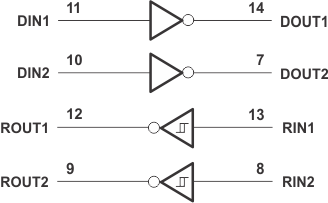SLLS664E August 2005 – June 2021 MAX3232E
PRODUCTION DATA
- 1 Features
- 2 Applications
- 3 Description
- 4 Revision History
- 5 Pin Configuration and Functions
-
6 Specifications
- 6.1 Absolute Maximum Ratings
- 6.2 ESD Ratings
- 6.3 ESD Ratings - IEC Specifications
- 6.4 Recommended Operating Conditions (1)
- 6.5 Thermal Information
- 6.6 Electrical Characteristics — Device (1)
- 6.7 Electrical Characteristics — Driver (1)
- 6.8 Electrical Characteristics — Receiver (1)
- 6.9 Switching Characteristics (1)
- 6.10 Typical Characteristics
- 7 Parameter Measurement Information
- 8 Detailed Description
- 9 Application and Implementation
- 10Power Supply Recommendations
- 11Layout
- 12Device and Documentation Support
Package Options
Mechanical Data (Package|Pins)
Thermal pad, mechanical data (Package|Pins)
- DW|16
Orderable Information
8.4 Device Functional Modes
Table 8-1 and Table 8-2 list the functional modes of the drivers and receivers of MAX3232E.
Table 8-1 Each Driver(1)
| INPUT DIN | OUTPUT DOUT |
|---|---|
| L | H |
| H | L |
(1) H = high level, L = low level
Table 8-2 Each Receiver(1)
| INPUT RIN | OUTPUT ROUT |
|---|---|
| L | H |
| H | L |
| Open | H |
(1) H = high level, L = low level,
Open = input disconnected or connected driver off
Open = input disconnected or connected driver off
 Figure 8-1 Logic Diagram
Figure 8-1 Logic Diagram